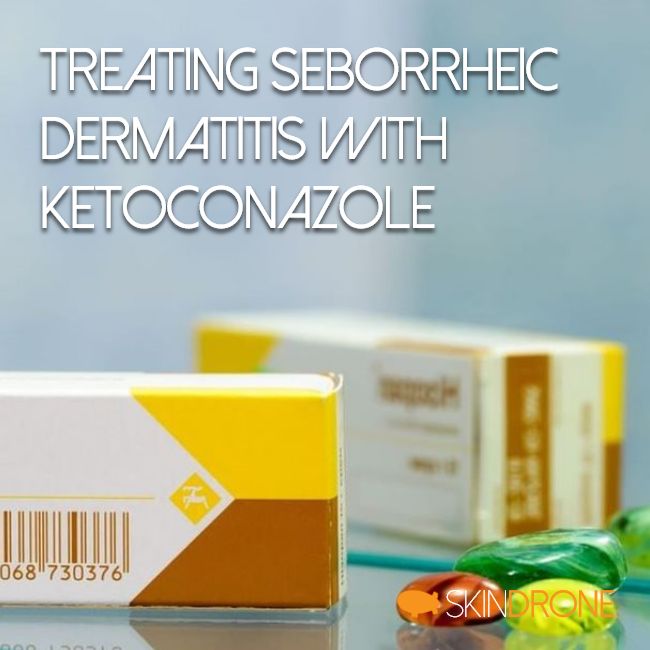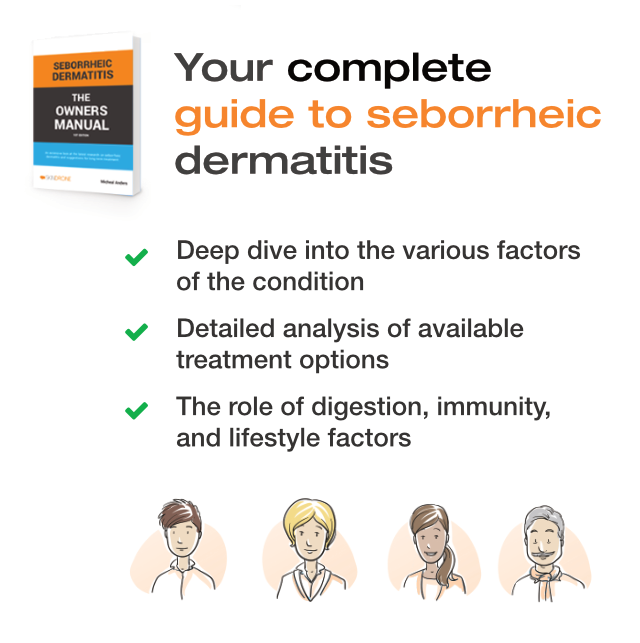Seborrheic dermatitis (SD) is a troubling skin condition characterized by red, greasy, scaly patches and stubborn dandruff flakes. It most often affects the scalp, face, ears, chest and back. For many sufferers, antifungal shampoos containing ketoconazole can help manage flare-ups and symptoms. This detailed article explores the science behind using ketoconazole to treat seborrheic dermatitis.
TLDR: Ketoconazole is a topical antifungal medication commonly prescribed to treat seborrheic dermatitis outbreaks. Research suggests it works by suppressing Malassezia fungi on the skin and reducing inflammation. Typical usage is a 1-2% shampoo or cream applied to affected areas 2-3 times per week long-term. Ketoconazole is generally safe when used as directed, but potential side effects include irritation, rash and hair changes.
Overview of Seborrheic Dermatitis
Seborrheic dermatitis is a chronic, inflammatory skin disorder that causes flaking, scaling, redness and itching. It occurs most commonly on oil-rich areas like the scalp, face, upper chest, back and groin. Dandruff is considered a mild form of seborrheic dermatitis limited to the scalp [1].
Seborrheic dermatitis has no known cure. Flare-ups can occur unpredictably, then disappear for a period before returning. Symptoms range from mild dandruff to stubborn, painful lesions and plaques.
While Seborrheic dermatitis can affect anyone, it is more prevalent in infants and adults between 30-60 years old. People living with HIV/AIDS frequently deal with severe, treatment-resistant seborrheic dermatitis [2].
[IMG: Photographs depicting mild to severe seborrheic dermatitis on scalp, face, ears, chest]
Seborrheic dermatitis is not contagious. The exact causes are not fully understood, but contributing factors likely include genetics, hormonal changes, stress, weather and malnutrition [1].
Treatment focuses on managing symptoms and preventing recurrent flares. Mild seborrheic dermatitis may respond to regular shampooing and over-the-counter remedies. More stubborn cases require prescription anti-fungal and anti-inflammatory medications.
Ketoconazole Mechanisms for Treating Seborrheic Dermatitis
One of the most prescribed medications for seborrheic dermatitis is ketoconazole. This topical antifungal interferes with the growth of Malassezia yeasts that live on the skin and contribute to SD flare-ups.
Ketoconazole overview
Ketoconazole belongs to the azole class of antifungal medications. Azoles work by disrupting the fungal cell membrane and inhibiting ergosterol synthesis [3]. Ergosterol is required for fungal cell wall formation and integrity.
Ketoconazole was introduced in 1979 and quickly became popular due to its broad anti-fungal activity [4]. It is used to treat a variety of fungal skin and nail infections.
For seborrheic dermatitis, ketoconazole comes as a shampoo, cream, gel or foam applied to affected areas. The concentration is typically 1-2%.
Antifungal effects against Malassezia
Research suggests ketoconazole’s main mechanism is killing Malassezia yeasts on the skin. Malassezia are a genus of lipophilic fungi that thrive on sebum and naturally inhabit human skin.
In those predisposed to SD, Malassezia yeasts are thought to proliferate and elicit an inflammatory response in the skin. This leads to the characteristic itching, redness and flaking [5].
In laboratory testing, ketoconazole demonstrates potent antifungal activity against various Malassezia species. Test tube studies show it can damage the fungal cell membrane and inhibit growth [].
However, one small 2016 study on 6 SD patients found that while ketoconazole improved symptoms, it did not reduce Malassezia fungal counts over 2 months of treatment [].
So while antifungal effects likely play a key role, ketoconazole may also improve SD through other mechanisms.
Other potential mechanisms
If ketoconazole isn’t reducing Malassezia numbers, what else could explain its benefits? Other hypothesized pathways include:
- Altering fungal gene expression – Ketoconazole may reduce fungal virulence factors without killing the yeasts themselves [6].
- Altering human gene expression – It could improve the skin’s barrier function and immune defenses against Malassezia.
- Anti-inflammatory effects – By suppressing inflammatory responses to the yeasts colonizing the skin [].
Further research is still needed to elucidate the precise mechanisms behind ketoconazole’s efficacy in seborrheic dermatitis. It likely goes beyond simple antifungal activity.
Clinical Usage and Dosing of Ketoconazole
Based on the current evidence, how is ketoconazole used clinically for treating seborrheic dermatitis flares?
Treatment protocol
Topical ketoconazole is commonly prescribed to manage seborrheic dermatitis affecting the face, scalp, chest and other areas. It can be used for mild dandruff or more severe, widespread lesions.
The typical protocol is to apply a 1-2% ketoconazole preparation to affected areas 2-3 times per week in place of regular shampoo or as a leave-on overnight treatment.
For the scalp, ketoconazole shampoo is massaged in, left for 3-5 minutes, then rinsed out. Creams, gels and foams are left on the skin overnight before rinsing off in the morning [7].
Duration of treatment
Patients are often advised to continue using ketoconazole regularly for 4-8 weeks to gain initial control of SD symptoms. Ongoing maintenance is required 2-3 times per week to prevent recurring flares [7].
The chronic nature of seborrheic dermatitis means most patients need to incorporate long-term ketoconazole treatment into their regimen.
Adjunctive therapies
Alternative and sufficiently researched treatment options include:
- Coal tar – Additional antifungal and anti-inflammatory effects
- Salicylic acid – Helps lift and shed excess skin
- Phototherapy – For severe, resistant cases unresponsive to topicals
- Mild corticosteroids – Help resolve underlying inflammation (possible long term complications are often noted)
Using ketoconazole along with complementary treatments can optimize management of troublesome seborrheic dermatitis.
If you’re seeking natural remedies to manage seborrheic dermatitis, there are several holistic options that have shown promise for some individuals:
- Tea tree oil – Boasting anti-inflammatory, antibacterial, and antifungal properties, it can be diluted and applied to affected areas or incorporated into shampoos.
- Aloe vera – With its soothing and anti-inflammatory effects, aloe vera gel is a popular choice for addressing seborrheic dermatitis.
- Honey – Offering antimicrobial properties and moisture retention, honey may alleviate scaling when applied to affected areas.
- Probiotics – Probiotics, especially specific strains like Lactobacillus paracasei, have been investigated for their potential in improving gut health and immunity, which can influence seborrheic dermatitis.
- Stress management – It’s important to note that chronic stress can exacerbate seborrheic dermatitis, and relaxation techniques like meditation may offer relief.
- Diet modification – For some, restricting the consumption of oils, dairy, and sugar may be beneficial. An anti-inflammatory, well-balanced diet can also play a significant role.
Prior to trying any new remedies, it’s advisable to consult with a dermatologist to ensure their suitability for your specific condition. Although natural approaches hold promise as part of a comprehensive strategy, further research is required to fully understand their effectiveness.
Safety Profile and Side Effects
When used correctly, ketoconazole is generally well tolerated. However, mild side effects are possible and require close monitoring.
General safety
The most common ketoconazole concentration prescribed for SD is 1-2%. At this strength, numerous studies confirm it is safe for long-term use if directions are followed properly [8].
One study of 246 people found no adverse effects in the 97 using ketoconazole shampoo, compared to 9 of 100 people who reported reactions to selenium sulfide [9].
Still, potential mild side effects can include:
- Scalp dryness or irritation
- Itching or burning
- Rash
- Hair discoloration or texture changes
These are often temporary and resolve with continued use. But always inform your physician of any reactions.
Liver toxicity
Oral ketoconazole has been associated with rare liver toxicity. However, topical ketoconazole has not shown this risk when used properly.
One review looked at 23 years of adverse event reports and found only 8 cases linking topical ketoconazole to liver issues. All involved improper use, misdosing or accidental ingestion [].
Pregnancy and breastfeeding
Always consult a doctor before using ketoconazole while pregnant or nursing. There is limited safety data, but no evidence of birth defects. Potential risks should be weighed against benefits [1].
Patch testing
For some individuals, topical ketoconazole provokes allergic reactions or contact dermatitis. Patch testing on a small skin area for 24-48 hours can identify sensitivity before using on large affected regions [1].
The Takeaways
- Ketoconazole is a topical antifungal medication that can help manage troublesome seborrheic dermatitis outbreaks.
- It likely works by suppressing Malassezia fungi on the skin, as well as through anti-inflammatory and gene expression effects.
- Typical dosing is a 1-2% ketoconazole preparation applied to affected areas 2-3 times per week on an ongoing basis.
- When used exactly as prescribed, ketoconazole appears safe. But minor side effects are possible, and liver toxicity is a concern with oral versions.
- Speak with your dermatologist to see if prescription ketoconazole could be a useful addition to your seborrheic dermatitis treatment plan. With careful use, it may help tame flares and reduce aggravating symptoms.
Concluding Remarks
Seborrheic dermatitis is a troublesome skin condition that often requires long-term treatment to manage symptoms and prevent recurring flares. For many sufferers, incorporating topical ketoconazole provides much-needed relief from itch, redness and stubborn dandruff. Used properly alongside other medications and natural therapies, ketoconazole can be a safe, effective option for taming seborrheic dermatitis outbreaks. Have an open discussion with your dermatologist to develop the optimal treatment plan for your individual needs and goals.



No Comments
Be the first to start a conversation